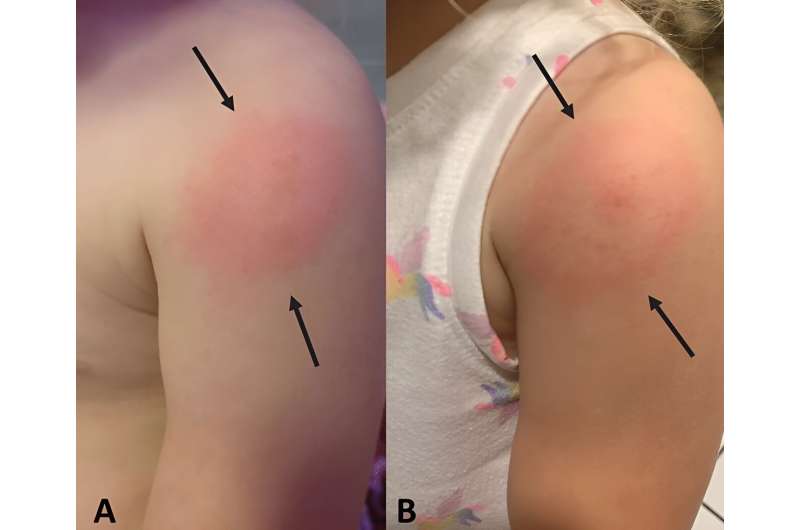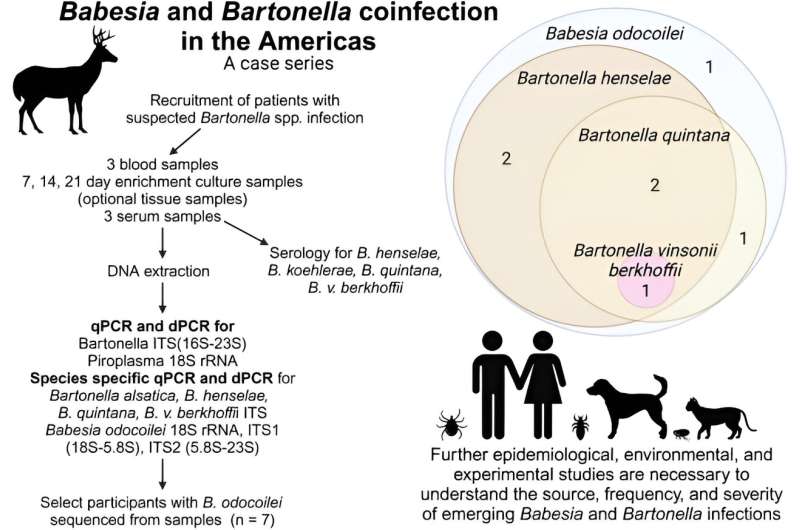This article has been reviewed according to Science X's editorial process and policies. Editors have highlighted the following attributes while ensuring the content's credibility:
fact-checked
trusted source
proofread
Bartonella and Babesia co-infection detected in patients with chronic illness

A small pilot study has found evidence of human co-infections from Bartonella and Babesia odocoilei, a protozoal tick-borne infection primarily found in deer, moose and other cervids. The co-infections were detected in six of seven patients suffering from chronic, non-specific illness, who were enrolled in a Bartonella study at North Carolina State University. The work presents some of the first definitive DNA evidence of this strain of Babesia infection in humans, and could impact treatments for patients with Bartonella, Borrelia or Babesia infections.
Bartonella are a group of vector-borne bacteria transmitted primarily via arthropods like fleas, lice and potentially ticks, but also by the animals that harbor them. There are at least 45 different known Bartonella species, of which 18 have been found to infect humans. Improved methods for detecting Bartonella infection in animals and humans have led to the diagnosis of bartonelloses in patients with a host of chronic illnesses, as well as in some patients with psychiatric symptoms.
In the U.S., the main Babesia species that infect humans are B. microti, B. duncani and B. divergens-like. Transmission occurs mainly by tick bite, but there are reports of transmission by transfusion of contaminated blood, organ transplantation and transplacental transmission. In addition to asymptomatic infection, babesiosis can be associated with non-specific symptoms such as fever, chills and night sweats, or with severe, life-threatening hemolytic anemia.
Babesia and Bartonella are often suspected as co-infections with Lyme disease, caused by the bacterium Borrelia burgdorferi.
"Doctors who work with Lyme patients often suspect co-infection with Babesia most often based on serology data and symptoms," says Edward Breitschwerdt, Melanie S. Steele Distinguished Professor of Internal Medicine at NC State's College of Veterinary Medicine and corresponding author of a paper describing the work. "So we decided to test for potential co-infections with this subset of our Bartonella study participants."
The seven patients in the pilot study were already enrolled in a larger study aimed at detecting Bartonella in the blood of people with chronic illness and extensive animal contact. The participants' ages ranged from two-and-a-half to 62 years old. Four were veterinary workers, one was a student and veterinary technician, one was a veterinarian's daughter and one was a pre-school aged child. All submitted blood and tissue samples for testing.
Using digital droplet PCR testing, which identifies pathogens by their DNA sequences, the researchers discovered that all seven participants were infected with Babesia odocoilei, and that six of the seven were co-infected with at least one, and sometimes two or more, species of Bartonella.

"We were surprised by these findings for several reasons," Breitschwerdt says. "First, this strain of Babesia—B. odocoilei—isn't currently considered a cause of human infection. Second, these patients reside in locations around the U.S. and in Mexico, so the distribution may be geographically widespread. Finally, we were able to identify these seven infected individuals within a one-year time period, suggesting that this may be a more prevalent infection than currently appreciated."
The findings could have implications for how patients with symptoms of vector-borne illnesses such as Lyme, babesiosis, or bartonellosis are tested and treated.
"The main symptom associated with babesiosis is acute, severe hemolytic anemia. None of these patients reported any such illness, a factor that could limit a doctor's decision to test for Babesia infection," Breitschwerdt says.
"This study primarily focused on patients with chronic illnesses and suspected bartonelloses. Most often, doctors don't look for Babesia in these patients, but we now have good evidence that people can be infected by this organism, evidence that should be pursued in larger studies. Physicians who treat Lyme disease have often suspected co-infections with these pathogens, and it looks like their suspicions are correct, at least in a subset of patients."
"We are committed to providing the best vector borne infectious disease testing results possible," says Ricardo Maggi, research professor at NC State and first author of the study. "The cases presented in this manuscript reflect our team's efforts to develop better approaches and diagnostic tools that can give answers to both patients and their doctors."
The study appears in Parasites & Vectors.
NC State Ph.D. student Charlotte Moore, São Paulo State University Ph.D. student Ana Cláudia Calchi, and NC State research specialist Emily Kingston also contributed to the work.
More information: Ricardo G. Maggi et al, Human Babesia odocoilei and Bartonella spp. co-infections in the Americas, Parasites & Vectors (2024). DOI: 10.1186/s13071-024-06385-4





















